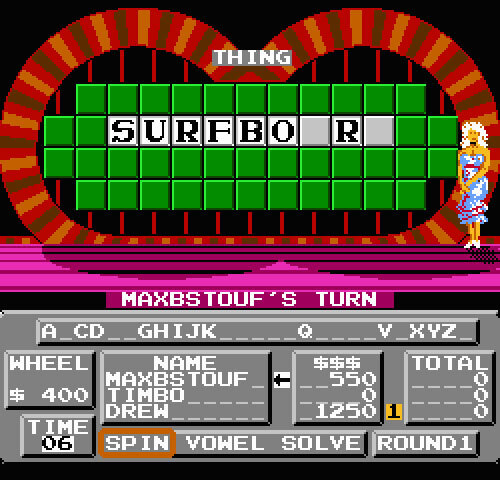
The NES version of Wheel … Of … Fortune!
Game shows have long been a popular form of entertainment with a strong history of innovation
Game shows have always held a measure of popularity and a permanent place as part of modern popular culture. From quiz shows and panels to reality programs and interactive games, the game show is thoroughly ingrained in our collective entertainment psyche. New and innovative shows come and go all the time—with the occasional scandal in between—and America’s love affair is undeniable—even if one of the first game shows was a Spelling Bee broadcast over BBC radio.
Per an excellent history of game shows by Magic Barry Entertainment, there’s a compelling reason why the population loves these programs:
Some experts assert that the game show’s popularity directly ties in with America’s lofty rags-to-riches dreams, wherein we love to see an average person win a fantastical vacation or pocket a million dollars for doing little more than showing up.
Some folks love game shows for the trivia or the competition. Whatever the case may be, it was only logical for games based on game shows to find their way into the home. For decades, board game versions of popular game shows like Jeopardy, Wheel of Fortune, and Concentration were a good way to capture the game show experience at home.
Later, video game versions of popular game shows began appearing on home consoles and personal computers. I used to love playing Family Feud on one of our old computers as a kid, but when we got Classic Concentration for the NES, I moved onto that system exclusively and ended up collecting numerous games from the same company—GameTek.
Founded in 1987, Florida-based GameTek basically came about as a means to utilize the licensing rights acquired by the company I.J.E, Inc., which included several game shows. With the exception of a few Fisher-Price branded titles on the NES, Gametek’s output on the system consisted primarily of games based on the two most popular game shows of the time: Wheel of Fortune and Jeopardy.
In 1988, GameTek brought the world their NES port of Jeopardy and just kept going from there. With a few exceptions like Super Talking Jeopardy and Wheel of Fortune Featuring Vanna White, Gametek served as just the publisher of some of the video games based on game shows. They had some help from other companies for game development like Softie (Classic Concentration) and Beam Software (Family Feud), but most of their output involved a company called Rare—the same company responsible for the likes of Battletoads and later, Donkey Kong Country. Rare developed a great deal of GameTek’s published output. Double Dare, Wheel of Fortune (along with both Jr. and Family Editions), Hollywood Squares, Jeopardy (along with the Jr. and 25th anniversary editions of the game) all were developed with Rare in some capacity. Rare would later develop Anticipation (published by Milton Bradley) and move onto bigger and better things.After a mere 10-year run, GameTek declared bankruptcy in 1997—a few years after the NES years faded into history.
As gaming evolved and smartphones became ubiquitous, even Jeopardy and Wheel of Fortune jumped to the smartphone market. Newer, more innovative game show-style titles like Trivia Crack came along incorporating players from across the world into their own interactive game show. Later, HQ Trivia came along and transformed the entire landscape of the interactive game show.

HQ Trivia is sort of the modern version of the video game based on a game show.
Per The Verge, HQ Trivia briefly became the “most popular daily, live interactive quiz apps that found its player base through the promise of cash prizes” before shutting down in early 2020 (although it returned shortly afterward).
Promising cash prizes and fun trivia in a live, interactive environment undoubtedly appealed to a large user base. Playing twice a day for real prizes through your own device was a unique way to experience the interactive game show from the comfort of wherever you were at the times the game started. HQ Trivia is an interesting part of game show history, inspiring much online discussion and at least one podcast series. (Editor’s note: I’m listening to it now. It’s pretty good.) Not to mention it was always fun to participate, even if I didn’t win anything.
Amid HQ Trivia’s successful run, the 2018 pilot for The video game Game Show appeared online (it appears to be a kind of interactive game show where the hosts play console games). A mere footnote in video game game show history, it pales in comparison to the shows that preceded it, especially the 1980s smash Starcade.